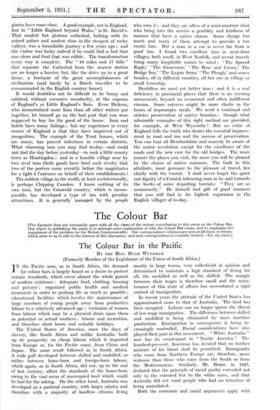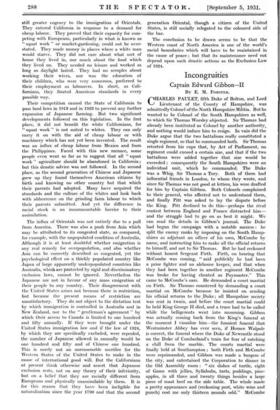The Colour Bar
rthe Spectator does not necessarily agree with all the views of the writers contributing to this series on the Colour Bar. Our object in publishing the series is to attempt some explanation of why the Colour Bar exists, and to emphasize the importance of the problem for the British Commonwealth. Our correspondence columns are open at all times to letters which seem to us to add to the interest of this discussion; and such correspondence is cordially invited.—ED. Spectator.)
The Colour Bar in the Pacific
BY THE HON. HUGH WYNDHAM (Formerly Member of the Legislature of the Union of South Africa.) TN the Pacific area, as in South Africa, the demand -1- for colour bars is largely based on a desire to protect certain standards, which cover almost the whole gamut of modern existence : Adequate food, clothing, housing and privacy ; organized public health and medical treatment in order to prolong life as much as possible : educational facilities which involve the maintenance of large numbers of young people away from productive labour 'to a relatively advanced age : exclusion of women from labour which may be a physical drain upon them as potential or actual mothers : leisure and recreation, and therefore short hours and suitable holidays.
The -United States of America, since the days of slavery, like South Africa and unlike Australia, built up its prosperity on cheap labour which it imported from Europe or, for the Pacific coast, from China and Japan. The same result followed as in South Africa. A wide gulf developed between skilled and unskilled, or rather between home-born and foreign-born labour, which again, as in South Africa, did not, up to the end of last, century, affect the standards of the home-born owing to the vast areas of unoccupied land which could be had for the asking. On the other hand, Australia was developed as a pastoral country, with larger estates and therefore with a majority of _ landless -citizens living mostly in large towns, very collectivist in opinion and determined to maintain a high standard of living for all, the unskilled as well as the skilled. The margin between their wages is therefore small and the main- tenance of this state of affairs has necessitated a rigid control of immigration.
In recent years the attitude of the United States has approximated more to that of Australia. The land has been occupied. Labour can no longer ignore the threat of low-wage immigration. The difference between skilled and unskilled is being eliminated by mass machine production. Immigration in consequence is being in- creasingly controlled. Racial considerations have also played their part in this movement. " White Australia " now has its counterpart in " Nordic America." The hundred-per-cent. American has decided that no further mixture of his blood shall be permitted. Immigrants who come from Northern Europe are, therefore, more welcome than those who come from the South or from the Mediterranean. Similarly, Mr. Bruce, in 1927, declared that the principle of racial purity extended not only to the coloured but to the white races, and that Australia did not want people who had no intention of being assimilated.
Both the economic and racial arguments apply with still greater cogency to the immigration of Orientals. They entered California in response to a demand for cheap labour. They proved that their capacity for com- peting with Europeans, particularly in what is known as " squat work " or market-gardening, could not be over- stated. They made money in places where a white man would starve. They did not care about what sort of house they lived in, nor much about the food which they lived on. They needed no leisure and worked as long as daylight lasted. They had no scruples about working their wives, nor was the education of their children, who were very numerous, preferred to their employment as labourers. In short, as Cali- fornians, they flouted American standards in every possible way.
Their competition caused the State of California to pass land laws in 1913 and in 1923 to prevent any further expansion of Japanese farming. But two significant developments followed on this legislation. In the first place, it did not benefit the white Californians, for " squat work " is not suited to whites. They can only carry it on with the aid of cheap labour or with machinery which has not yet been invented. The result was an influx of cheap labour from Mexico and from the Philippines. Faced with this new menace, some people even went so far as to suggest that all " squat work " agriculture should be abandoned in California ; but this drastic advice was not followed. In the second place, as the second generation of Chinese and Japanese grew up they found themselves American citizens by birth and knowing no other country but that which their parents had adopted. Many have acquired the standards and the culture of the whites and look back with abhorrence on the grinding farm labour to which their parents submitted. And yet the difference in racial stock is an insurmountable barrier to their assimilation.
The influx of Orientals was not entirely due to a pull from America. There was also a push from Asia which may be attributed to its congested state, as compared, for example, with the unpopulated condition of Australia. Although it is at least doubtful whether emigration is any real remedy for overpopulation, and also whether Asia can be correctly described as congested, yet the psychological effect on a thickly populated country like Japan of large apparently underpopulated countries like Australia, which are protected by rigid and discriminatory exclusion laws, cannot be ignored. Nevertheless the Japanese are not in favour of any mass emigration of their people to any country. Their disagreement with the United States arises not because there is restriction, but because the present means of restriction are unsatisfactory. They do not object to the dictation test by which immigration is controlled in Australia and in New Zealand, nor to the " gentleman's agreement " by which their access to Canada is limited to one hundred and fifty annually. If they were brought under the United States immigration law and if the law of 1924, by which they are specifically excluded, were repealed, the number of Japanese allowed in annually would be one hundred and fifty and of Chinese one hundred. This is surely not an unreasonable sacrifice for the Western States of the United States to make in the cause of international good will. But the Californians at present think otherwise and assert that Japanese exclusion rests, not on any theory of their inferiority, but on a belief that they are racially different from Europeans and physically unassimilable by them. It is for this reason that they have been ineligible for naturalization since the year 1790 and that the second generation Oriental, though a citizen of the United States, is still socially relegated to the coloured side of the bar.
The conclusion to be drawn seems to be that the Western coast of North America is one of the world's racial boundaries which will have to be maintained in the cause of peace ; but that its maintenance need not depend upon such drastic actions as the Exclusion Law of 1924.































 Previous page
Previous page